![]()
In previous sections, we discussed how to find valuable keywords and get your technical and on-page SEO done right. These are important foundational building blocks to build your SEO strategy upon, but in order to attract valuable backlinks to drive up your rankings, you’ll need to create, distribute, and promote high-quality content for your site. That’s what Content Marketing is all about.
As always, Baidu comes with its own unique challenges in addition to those associated with Google content marketing. Since this article is intended to provide insights for content marketing for Baidu SEO, we’re going to skip over some of the more basic components of general content marketing. For additional background on this topic, we recommend reading Kissmetrics’ introduction or Quick Sprout’s in-depth guide.
First, let’s discuss three main challenges international SEO will have to face in content marketing for Baidu SEO:
Plagiarism, content scraping, and theft of original content are a real issues in China. Due to the incredibly complex nature of Chinese natural language processing, Baidu’s algorithm still struggles to identify and penalize sites that steal content. As a result, SEOs in China are much more willing to engage in these types of black hat tactics. For sites that invest in high-quality content, vigilance against stolen content is imperative.
Chinese is one of the most difficult languages to learn for English speakers. Understanding how linguistic nuances affect the context of Chinese content is considerably difficult for non-Chinese readers. Proper care will need to be taken when putting together a China content marketing team.
Our observation suggests that Baidu’s knowledge graph does not cover as many entities as Google’s does. We believe this limits their understanding of a website’s topical relevance and context of each page. As a result, on-page keyword targeting has a disproportionately larger effect on organic rankings in Baidu than on Google. This is why it’s not uncommon for authoritative websites to rank well on Baidu for topics unrelated to their main site’s theme.
Here are a few recommendations for effective content creation for Baidu SEO:
If your website has been ranking well in Baidu in the past, newly published content with simple keyword targeting can often outrank competitors, even if the content has fewer backlinks.
We often see improvements in overall rankings, crawling, and indexation performance just by updating website content frequently. To keep up your website’s freshness, we recommend having at least one piece of content published on your website every day.
Although Baidu is not as skilled as Google in identifying duplicate content, they penalize websites much more harshly. The risk of stealing others’ content is definitely not worth taking. Don’t do it.
If a competitor site steals your content, publishes it on their site, and Baidu crawls their content before they notice it on yours, Baidu will assume your competitor is the original creator of the content.
By submitting URLs to Baidu as soon as they’re published, you can ensure your content is being indexed before anyone else has a chance, preventing spammers from stealing your content and using it to outrank you. Baidu provides multiple methods for webmasters to submit new content to Baidu, so be sure to take advantage of them.
To improve your site’s technical SEO, site architecture and internal linking, check out the Technical SEO section of our guide.
Based on our research, keeping the length of each article between 200 – 800 Chinese characters is a good goal. Any article with fewer than 200 words can be hard for Baidu to understand the article’s topic, while articles with thousands of words will take longer to create. It’s also important to note that Baidu has a lower tolerance to excessive keyword density, so don’t worry about how many times you’ve used each keyword — just make sure your content flows naturally.
Conduct keyword research to help you generate content ideas and analyze the potential ROI of content creation. Ideally, keyword research should drive which content you create. Find the best keywords to target, then create new content for each group of keywords with similar search intent.
Check out our Keyword Research section to learn how to find the best keywords for your site.
Any content marketing strategy should start with a deep understanding of your competitive landscape. A thorough competitive content analysis will need to answer these three questions:
Learn about on-page optimization and link building strategy in dedicated sections of our guide.
Unless you already have a team of native-speaking content marketers in-house, you’ll need a strategy for where all this content is going to come from. International organizations have several different options for setting up a Chinese content creation team. Let’s take a look at some of the best options to see which one is best for your site.
In this structure, the organization already has a content creation team, but no Chinese writers. The content creation team writes the content in their native language, and uses a translation service to translate the content into Chinese.
The team doesn’t need to be able to write or understand Chinese, but will need good SEO, copywriting and marketing experience in Baidu and China. They will also need to be able to find trustworthy translation partners — without any knowledge of Chinese, their ability to conduct quality assurance of the translated content will be minimal.
Flexible and relatively low-cost. High-efficiency as long as the translation service is of good quality
Since all content will be produced from a non-Chinese perspective, it will be much more difficult to create content that resonates with local users. Understanding the local search demand, culture, and value system are key factors of how content will be perceived. Also, quality will be very hard to control since the in-house team will not be proficient in Chinese to proofread the translation service’s work.
Lowest
This is the fully in-house operation. The organization hires a full-time team of Chinese content marketers in-house.
The organization will need to either have a local presence in China, or need to find Chinese writers with SEO skills in their international office locations, which can be extremely difficult.
Content quality and volume is fairly easy to maintain. Valuable insights and experiences gained by being fully responsible for the whole content marketing strategy can help the whole company in long run
Staffing can be extremely difficult and expensive. May take a relatively long period to see ROI.
Medium to High
In this structure, the organization has a local SEO or digital marketing team, and hires freelance writers for copywriting.
The team will need to have experienced people with SEO and marketing knowledge, as well as excellent communication skills. Freelance writers with at least basic SEO knowledge will need to be located.
High output volume may be achievable due to the outsourced nature. Costs are fairly low and flexible
Content quality can be poor if not managed properly
Low
Hire a local agency, or an international agency with a local physical presence in China to handle all content marketing.
Local staffing will not be necessary. The only requirements are to locate a trustworthy agency and have in-house marketers with a basic understanding of Baidu SEO.
Content quality is typically high and stable. Volume can be tailored to client’s requirements and budget. Easy to manage since reporting is often provided by them as well.
High cost. Will require time and effort to find and assess a trustworthy agency.
High
The optimal structure will be different for every organization, and will depend on the amount of investment, risk, and long-term strategy in China. In general, hiring a specialized agency will be best when starting expansion to China. As the organization’s presence in China matures, moving slowly towards investing in a local in-house team may be the best option.
How to pick the right agency from Moz
To get a bit more depth and breath into a particular industry, it’s often useful to conduct content research. This type of research can help with:
Outside of China, we often look at sites like Quora, Twitter, Reddit, Facebook etc. However, most of these sites are either blocked in China or not relevant. Here are a few platforms we often look at when conducting content research in China.
There are a number of Q&A community platforms in China, but we feel that Zhihu tends to deliver the highest quality content, with many useful insights into the China market.

Since content pages on Zhihu are indexed by Baidu, we can use the site: search operator to search for content on Zhihu. Try the following search query to look for relevant conversations on your search term:
{search term} site:zhihu.com
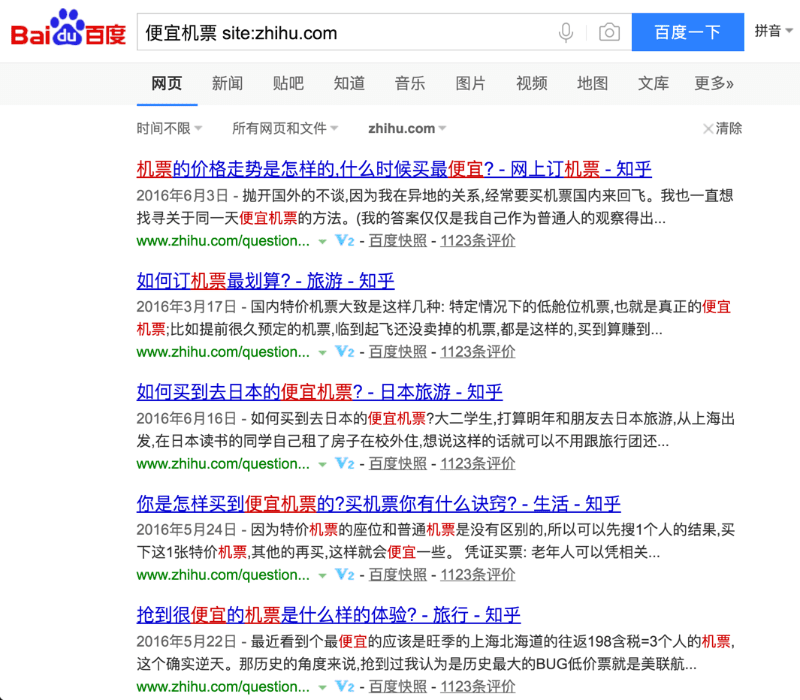
Baidu Zhidao is one of the oldest Q&A community platforms in China. Although from our experience, we believe the content on Zhidao is not as high quality as Zhihu, it has the advantage of volume, and therefore is still a good way to get additional insights for certain topics.
<p class="p1">
<span class="s1">Just like Zhihu, you can search for content on Zhidao with Baidu. Use this search query:</span>
</p>
{search term} site:zhidao.baidu.com
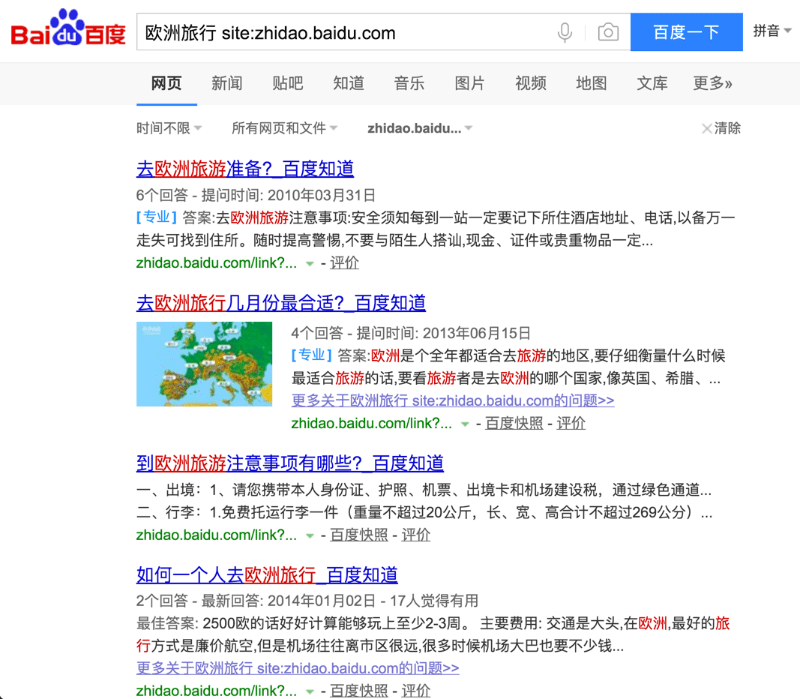
As one the biggest social media platform in China, Sina Weibo can be very useful not only for content and keyword research, but also discovering influencers, understanding your audience’s language and accessing the feasibility of using Weibo marketing for your niche.
While Weibo’s active user numbers has declined compared to a few years ago, losing many users to WeChat, it still has quite an active community. News tends to break on Weibo first, before funneling into WeChat where it reaches a wider group of users.
Since Weibo is not fully indexed by Baidu, using the search feature within Weibo itself is going to get better results than searching in Baidu. Here’s an URL you can use to search for different posts, users and images in Weibo:
http://s.weibo.com/weibo/{search term}

Similar to Sina Weibo, WeChat can be useful for researching topics and consumers’ online behavior.
Compared with Weibo, WeChat is a far more closed platform, focused on one-on-one messaging. Therefore, minimal content is available for indexation by search engines, and very limited marketing data is publicly available. Because of this, researching on WeChat can be rather time-consuming. However, due to its popularity in China there is still a lot of unique content and insights available for marketers that are willing to dig deep.
There are 2 primary ways to conduct research in WeChat:



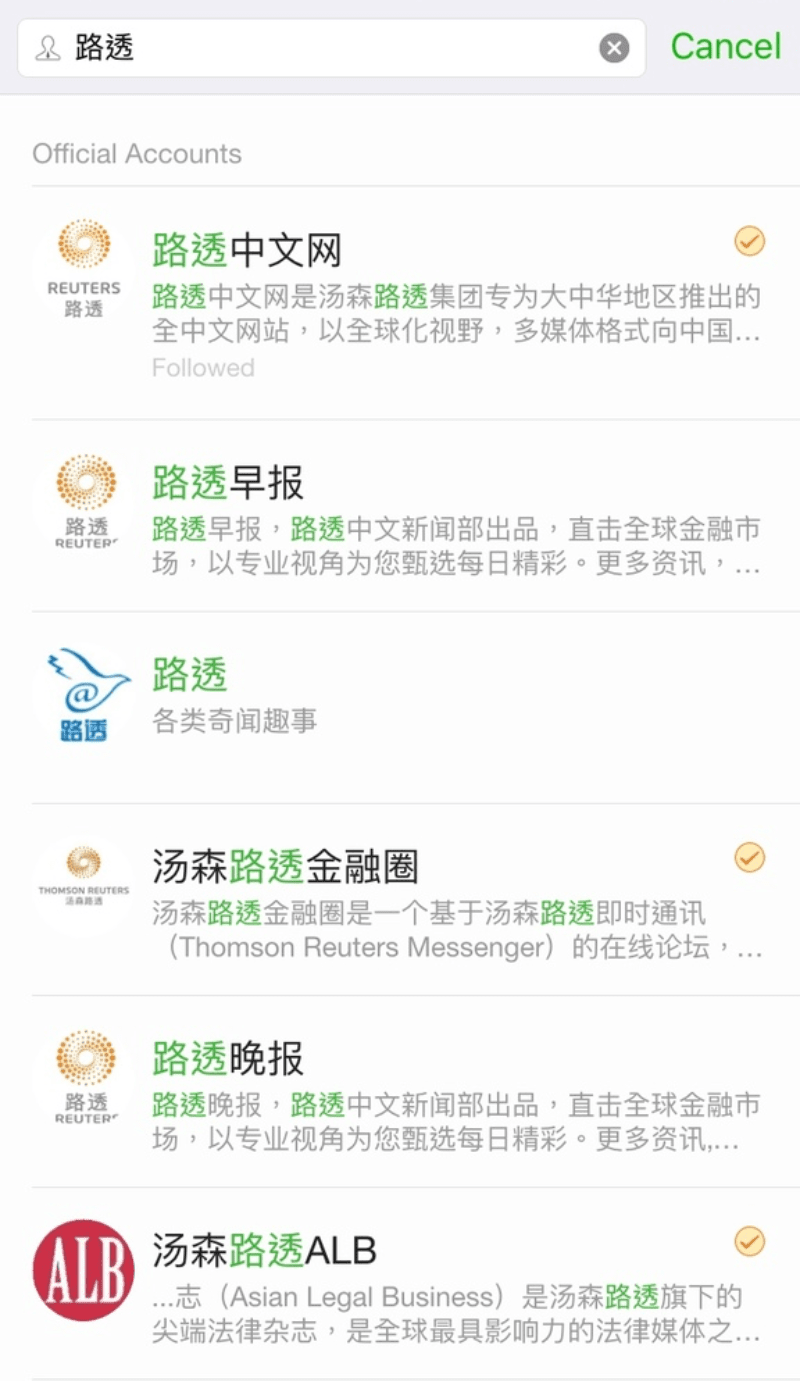
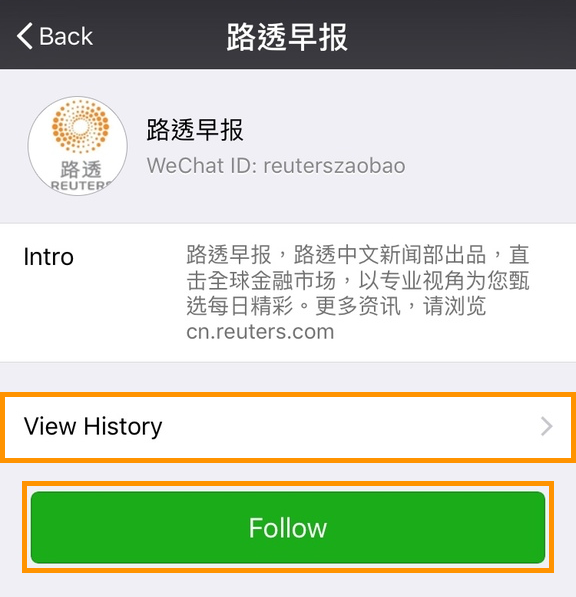
Forums in China can be helpful at times, but many of them are suffering from lack of moderation, so they’re often loaded with spam. Also, because forum discussions are not as popular as they once were, most of the best quality content on forums was published at least a few years ago. Depending on your research requirements, you might not want to look into forums at all. If you decide to do so, expect it to be the most time-consuming process of any of the sources listed above.
Running a content analysis on competitors can be a valuable source of ideas for content topics, backlink sources, keyword research, and optimization tactics.
Doing competitor content analyses manually can be an extremely inefficient, error-prone, and time-consuming task. To do it properly, you’ll need to use software tools to help. Dragon Metrics provides a suite of tools to assist with competitor content analysis, but there are plenty of other tools out there that can do the job as well. We’ll cover how to use Dragon Metrics for competitor content analysis in this guide, but feel free to use any other tool you prefer.
Dragon Metrics Baidu Research Tool will instantly show you any site’s top 50 competitors on Baidu organic search. These competitors are determined by our database of millions of keyword rankings on Baidu across a wide range of topics and industry. We analyze every site to see which other domains compete for the same keywords in common, and measure the organic visibility of each.
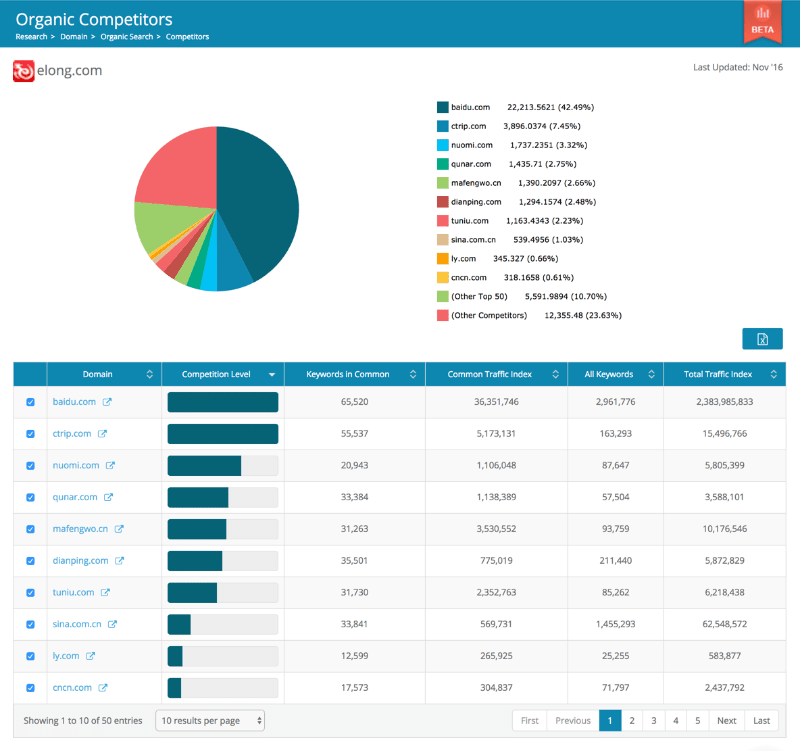
Finding your overall competitors can be valuable, but competition happens at the individual keyword level. If your site offers different categories of products or services, each one could have very different competitors.
For example, if a travel site sells both plane tickets and hotel bookings, your overall competitors will only be sites that also sell both plane tickets and hotel bookings. If you separate these into different groups, you may find some sites that are very competitive for only plane tickets while others are only competitive for hotel bookings.
Dragon Metrics Competitor Discovery helps you categorize your keywords into tightly-themed groups. For each group of keywords, the top ranking 50 sites will be displayed. This can help you get a more comprehensive understanding of the competitive environment.
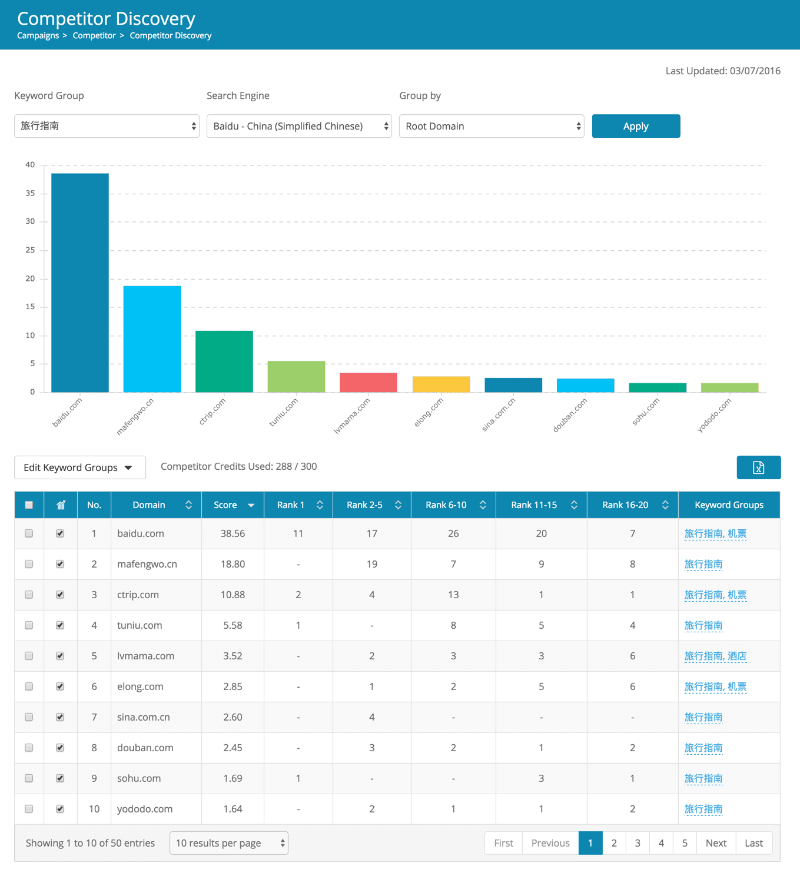
Once you know who your competitors, you’ll want to start to look at their best performing content on Baidu. The Competitor Organic URLs report in Dragon Metrics shows each site’s URLs that receive the most organic traffic from Baidu. Use this information to understand the type of content that they’re producing that is outranking your site, and consider producing similar or better content.
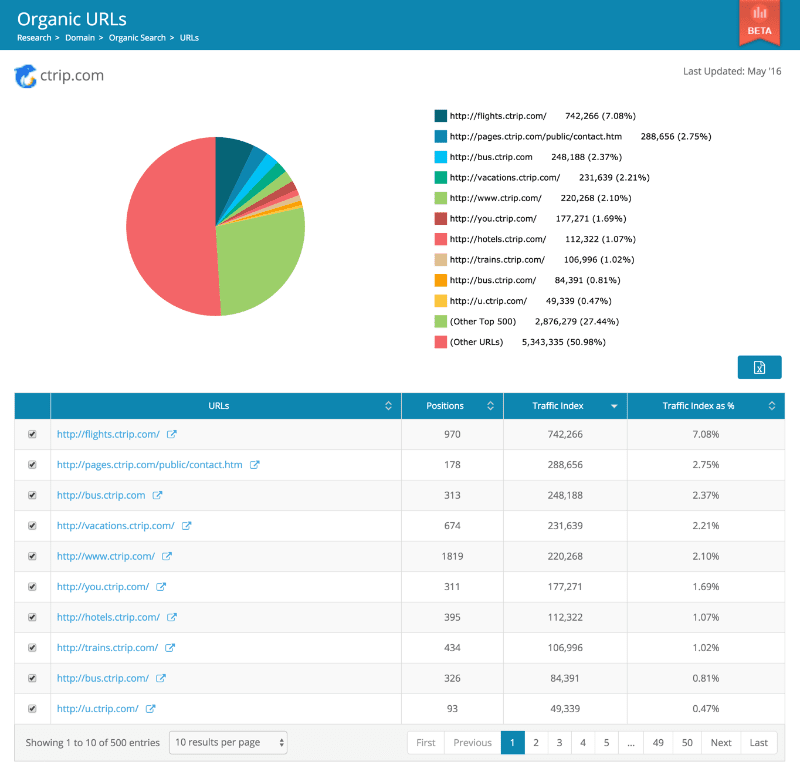
You can also view competitors’ top ranking content for each individual keyword as well.
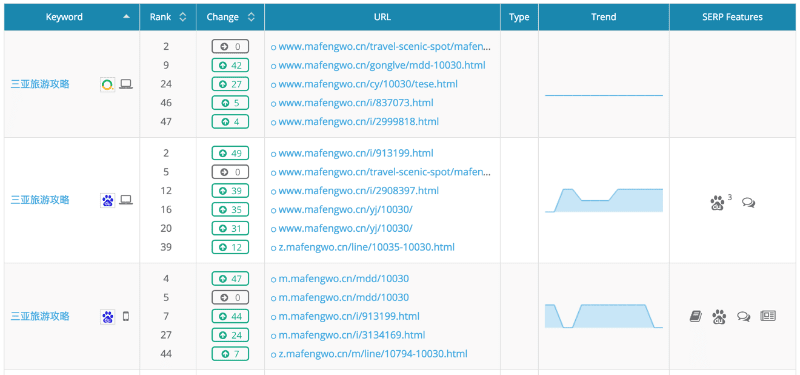
In addition to analyzing top content by rankings, you can also look at their top content by backlinks. This report will show you which pages on the competitor site receive the highest number of backlinks.
Lastly, you can run a full backlink research report on each competitor to see which backlinks they’re currently receiving. This is a great opportunity for outreach, to try to get backlinks from these sites as well.
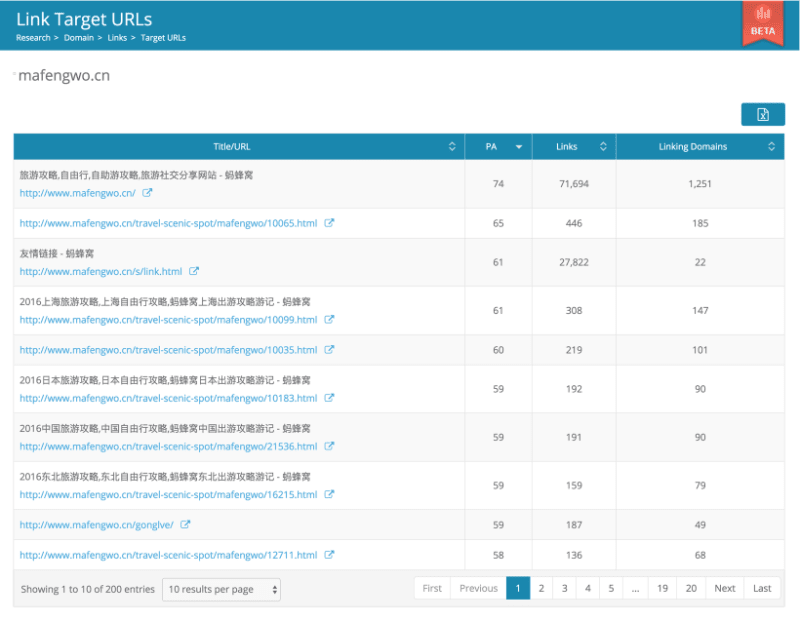
Now you know who your main competitors are, their top ranking content, and their top backlinks, it’s time to put this data to good use.
If you find there are many long-form pieces ranking high in a particular keyword group, this could be a sign that this format tends to rank the best for these types of keywords. Similarly, if you notice videos, infographics, short blog posts, Q&A’s, or other content formats consistently ranking well, this is a good signal for the type of content you might want to consider creating.
Inspect and learn from on-page keyword strategies of top ranking pages. Check for keyword usage in body content, titles, descriptions, and other meta tags. This is a great source for keyword research.
Organic rankings are a relative game. Take a look at what is ranking well for your target keywords. If it’s long-form, high quality content, you better bring your A-game if you want to compete. In contrast, if you only notice low-quality, thin, or poorly-written content ranking well, this is low hanging fruit: You may not need to spend hours and hours writing high quality content to rank well for these keywords.
If your competitor’s content is outranking your site, it’s very likely they have more and higher quality backlinks than your site. At the same time, sites that link to your competitors are typically more likely to link to your site as well. Use this as an outreach opportunity to start a relationship with these sites to eventually win backlinks from them.
Check out the Skyscraper Technique from Backlinko for a detailed framework for competitive content development
The final component of successful content marketing is promotion. According to the 80/20 rule of blogging, 20% of your time should be spent on creating content, while the other 80% should be promoting what you created. As this topic is closely related to link building, we’ll save the details on this subject for next chapter.
Although there are a number of differences at the tactical level between content marketing in Baidu and Google, the primary concept remains the same — Drive targeted traffic by creating content valuable to your targeted audience.
As content marketing is less mature in China than other countries, there will be less competition overall. We believe that international marketers that understand how content works in Baidu will have a much better chance of running successful SEO campaigns on a consistent basis.
Chapter 5 : Link Building
![]()
Chapters
Chapter 1
Chapter 2
Chapter 3
Chapter 4
Chapter 5
Chapter 6
Chapter 7
Chapter 8
Chapter 9
Chapter 10